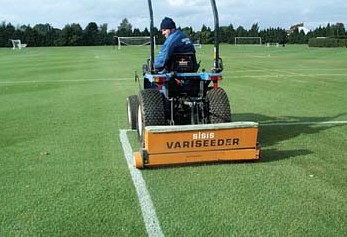At some point of a renovation it will be necessary to apply seed. This can be done by various methods. Features such as disease resistance, shade tolerance, colour, shoot density and wear tolerance should be taken into account. It is a good idea to speak to one of the seed houses that have people that can advise on such matters.
Seed Sowing
The two most common mechanical methods of seeding in rugby pitch maintenance are over seeding and direct drill seeding. The latter is probably the favoured option for use during the close season renovation when groundskeepers have a bit more time to establish a sward.
When drill-seeding, groundskeepers look to sow the seed in a manner that will encourage a tight knit sward to develop. Most direct drill machines sow the drills at 100mm (4 inch) centres. The machine then has to pass several times over the pitch in different directions to give the new grass a chance to knit together. The machine shown in the picture is the verti–seed. The verti–seed can sow drills in at 35mm centres. This means that in one pass the total amount of seed can be applied. The advantage of this is that the tractor does not have to keep running over the drills from previous runs. One impressive feature of the machine is the way it drops the seed into the drill having first cut it open. The machine also has the ability to close the drill over again to protect the new seed. The big advantage of the seed being in the drill is that it will produce stronger plants. This will also help to protect the plants against potential bird damage. It is sometimes necessary to seed in the season.
Groundskeepers will always look to minimise surface damage if this has to been done in the season. One method of doing this is to over – seed. Over seeders usually have a roller on the front of them fitted with short spikes? These insert hundreds of holes into the ground. The seed is then dropped out of the hopper and into the holes. The take up of seed is not usually as good as direct drilling but can still be reasonably successful if done properly.
Direct Drill Seeding
This is when the seed is drilled below the ground. Such machines that carry out this work usually cut a groove in the sward dropping the seed in behind the cutting disk. The groove is then closed over. Seed sown in this manner generally produces a stronger plant. Pitches are drilled in two or three directions. The depth of the drills is approx 5mm.
Over Seeding
Machines are usually fitted with a roller with small spikes attached. This roller precedes the seed box Once the holes are made the seed drops out the back of the box into the holes. This method is preferred if seed has to be applied during the season.
Broadcasting
This is the traditional method. It is not accurate because of the difficulty in spreading the same width over a long time


 Tweet
Tweet